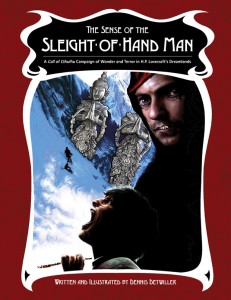 In June 2013 I began running The Sense of the Sleight-of-Hand Man, our new Call of Cthulhu campaign set in H.P. Lovecraft’s Dreamlands, for my local gaming group in Inverness, Alabama. I’m keeping an Actual Play journal of the campaign. These are some notes on the special rules that apply for the campaign and some of my personal house rules that might come up.
In June 2013 I began running The Sense of the Sleight-of-Hand Man, our new Call of Cthulhu campaign set in H.P. Lovecraft’s Dreamlands, for my local gaming group in Inverness, Alabama. I’m keeping an Actual Play journal of the campaign. These are some notes on the special rules that apply for the campaign and some of my personal house rules that might come up.
Character Creation
In The Sense of the Sleight-of-Hand Man, we recommend a few tweaks to the typical Call of Cthulhu character creation rules. In the waking world, the Investigators each get +3 POW (to a maximum of 18), but their SAN starts at POW x 4 rather than POW x 5 and each begins with drug addiction as an indefinite insanity.
In the Dreamlands, when the Dreamers take on strange new bodies, they must roll their physical attributes from scratch—but they get bonus points to reflect the unwitting influence of each Dreamer’s psyche. The higher the POW compared to INT and EDU, the bigger the bonus. Since these are the Dreamlands, this can bring a physical attribute higher than 18.
Healing in the Dreamlands
In The Sense of the Sleight-of-Hand Man, author Dennis Detwiller recommends a new rule where any Dreamer in the Dreamlands can heal from damage by spending magic points. This doesn’t take a spell, just an act of will. As the player characters in my game first were injured, I introduced this rule very gradually. It first came up when Sam Ford was cut down, nearly killed and left unconscious by a vicious scimitar stroke. Elissa Von Dale went to him and attempted First Aid. Her roll failed, but I asked the player how desperately she wanted him to recover—measured on a scale of zero to 17 (her current magic points), where 17 would leave her unconscious from the effort. Her player said “about nine,” since she didn’t want him to die but wasn’t convinced this wasn’t all a hallucination anyway. I told Elise to mark off 9 MP and told Sam he regained 9 HP. In a later session we explored this a little further and the relationship between willpower and healing started becoming clear.
House Rules
I am using a number of house rules to spice up combat in Call of Cthulhu for this Dreamlands campaign, where hand-to-hand combat is frequent and doesn’t necessarily carry quite the same mood-destroying connotations as in traditional Call of Cthulhu. None of these are official or recommended in The Sense of the Sleight-of-Hand Man; they’re just my personal jam. I’m listing them here in case they come up in the Actual Play reports.
Hide and Sneak: I consolidate these both into a single Sneak skill.
Weapon Skills: I allow a fixed 25% base skill for weapons rather than using the very low base chances for some weapons (such as 10% for fencing foils) in Call of Cthulhu.
Dodging and Parrying: I borrow a rule from the original Stormbringer and Hawkmoon rules—if you successfully Dodge or parry, you can attempt another Dodge or parry roll that round but at –20%. The penalty is cumulative and once you fail you can’t make another attempt.
Defense Points: I also am adding a new house rule saying that the Dodge skill reduces damage a little even without attempting a roll, as long as you’re mobile enough to flinch away and are not surprised. The reduction equals 1/20 your Dodge skill, rounded off normally. With 50% in Dodge, you reduce damage from each attack by 3 points unless your surprised by it or immobilized.
Armor: Rather than the static protection of standard Call of Cthulhu armor, I borrow another rule from the old Stormbringer book and use variable protection. Lightweight armor blocks 1D6+1 damage from each blow, or 1D6–1 if you aren’t wearing a helmet. Wearing even a little armor reduces Dodge and other physical skills, and CON rolls to resist exhaustion. Wearing a helmet reduces perception skills. The heavier the armor, the worse the penalties.
Shields: In this particular campaign I use a different set of rules from other BRP games. Instead of having a dedicated “Shield” skill I let players use Dodge or a weapon parry roll to use a shield—and with a shield the character can roll Dodge (to parry with the shield) and also attack in the same round. A shield reduces damage by its HP (typically 12). Each time it takes damage exceeding its HP it loses one HP.
Critical Hits: An impaling weapon impales as usual with a critical hit. But other combat rolls have special effects, too, if the attack roll is 1/5 the skill or lower. With a cutting weapon or unarmed attack you gain an extra attack. With a blunt weapon you do maximum weapon damage (but still must roll for a damage bonus). With a parry you can force the attacker to drop the weapn or you can gain an extra parry roll at no penalty. With Dodge you can force the attacker to fall prone or you can gain an extra Dodge roll at no penalty.
One thought on “‘The Sense of the Sleight-of-Hand Man’ – Actual Play in Inverness: Rules Notes”